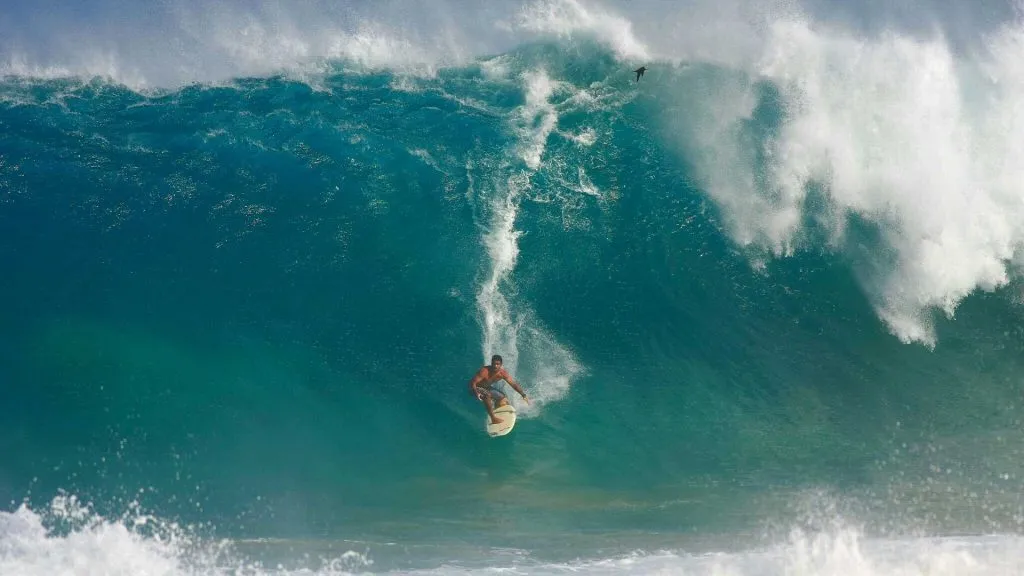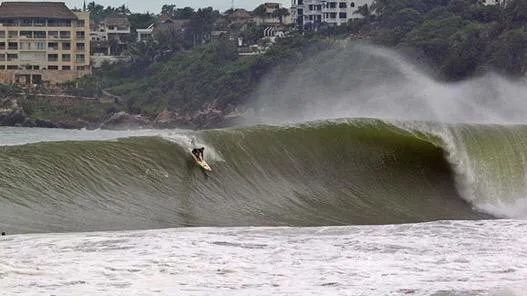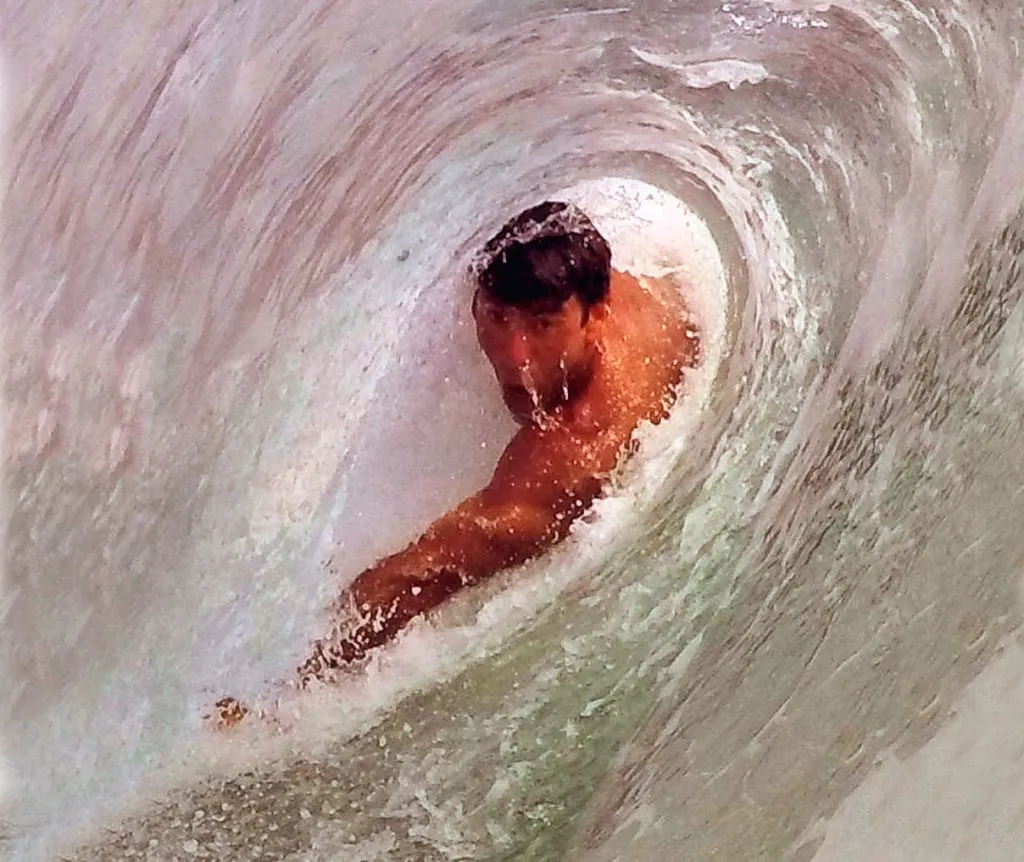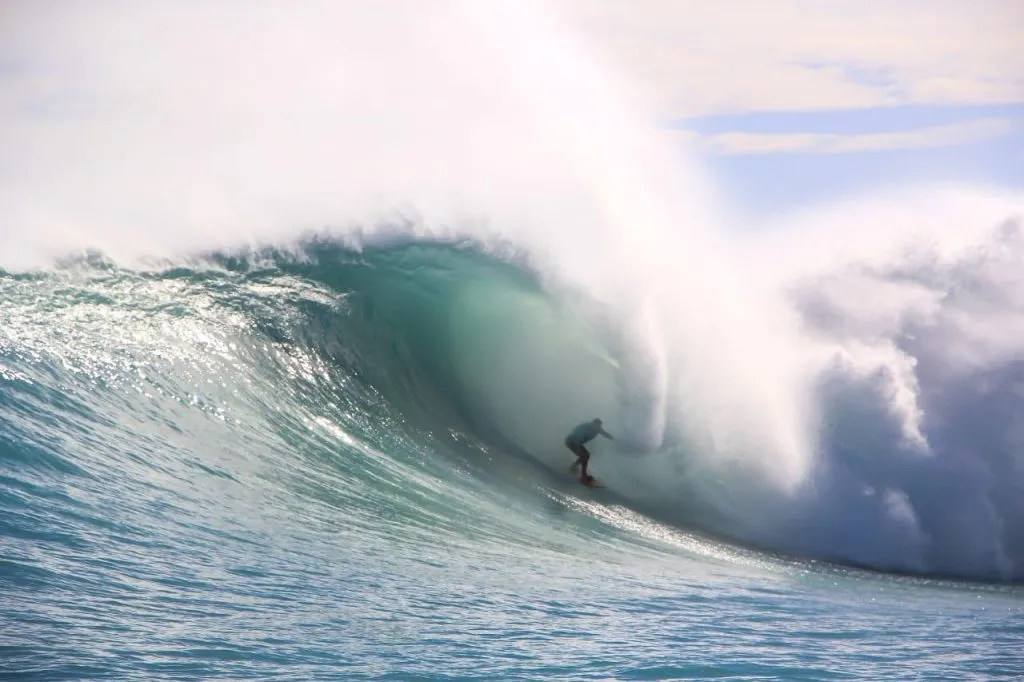English [🇺🇸]
Hi everyone!
When we talk about big wave surfing, massive thoughts occur. “Are these people crazy?”; or: “Don’t they have love for life?”; or: “That’s just not having anything to do!”. However, few understand that being a big rider is a profession with an absolutely high risk and that, yes, surfers know this well. However, there is specific preparation for surfing to take place in these conditions. A board and courage are not enough to deal with huge seas.

Photo: Aldemir Calunga in Fernando de Noronha, by Aleko Stergiou.
Fortunately, Brazilian big riders have increasingly become a reference around the world. And this is not something recent, since big names were responsible for boosting the sport in Brazil for years and years until it got to where we are. One of them is the experienced Aldemir Calunga from Rio Grande do Norte, who has been surfing big waves since he was 15 years old, in Fernando de Noronha. Today, at 46 years old, Calunga has traveled the world in search of the most feared waves in the world, such as Jaws, Pipeline, Puerto Escondido, Teahupoo, Waimea and many other peaks.
Aldemir Calunga between life and death in Puerto Escondido
In September 2012, Calunga faced death up close. After riding a wave in Puerto Escondido, Mexico, and carrying a cow, the big rider was sucked into the body of water, being dragged by the board, attached to him by the leash. Amid the turbulence of the water, he was hit hard in the face by the board, causing him to lose consciousness. Calunga remained underwater for around six minutes, until he was rescued by experienced big wave surfer and lifeguard Marcos Monteiro.
Taken to the hospital in serious condition, Calunga spent 16 days in the ICU, of which seven days were in a coma. This, however, was not the first setback in his career as a big rider. In fact, anyone who wants to surf really big waves needs to always be prepared for the worst-case scenario.

Photo: Aldemir Calunga in Puerto Escondido.
In 1999, when he was surfing a heavy swell, in Waimea, with sets reaching 25 feet, Calunga got caught and spent a lot of time underwater, during two heavy waves. No matter how hard he swam to escape that swirl of water, the surfer was unable to surface to breathe. “That day was very memorable too. When I finally managed to reach the surface, there were people in containment with lifeguards. My leash had burst and my nose was bleeding because a vase had burst. I quickly left the sea to put on a leash and returned to the outside”, reports the big rider.
Leash and bodysurf
Ok. But then what is the relationship between Aldemir Calunga, leash, big waves and bodysurfing? Initially, the leash is currently considered a basic safety item for surfing, but in the past, it was considered superfluous.
Calunga remembers that before the invention of the leash, every good surfer was a good swimmer and/or an excellent diver, in addition to knowing how to bodysurf, taking advantage of the energy of the wave to move. He guarantees that the people of that time loved carrying broth and that they were very comfortable underwater: “The leash was created decades ago, but what happens is that in some places, like Puerto Escondido, the leash, in addition to making causing the board to return to your face increases the risk of it breaking in half, as it is always in the impact zone, tied to the surfer”, he reveals.

Photo: Aldemir Calunga bodysurfing in Brazil, by Erico Frota.
The wave at Puerto Escondido is tubular and so heavy that breaking boards there is very common. For this reason, Calunga states that in the past, not “falling off” with a leash was a way of preventing yourself from getting hurt and also not having your best board break immediately.
The surfer also says that when he was carrying that heavy drink and was rolling around underwater, his great desire was to leave the sea, get out of there and get to his comfort zone: the sand. “When I took the hit from the lip of the Puerto wave, I was in that whirlwind. So, I always went down a little to the water level to protect myself because there we always got that push from the water itself. I just had to leave my body relaxed enough for the sea to propel me to the edge of the beach”, he says.
In fact, Calunga remembered the tips from a very dear American friend, who passed away after suffering a cow in Puerto in 2010. Noel Robinson joked that when big waves of 10 to 15 feet rose in front of him and there was no alternative, The best thing was to lie down with your legs up in the air. Because, in this position, his body would be projected towards the beach faster. “He said he turned into a dolphin when he did that and went to the edge. I did this a few times and it really worked. Noel did this and it worked, so much so that he always managed to get to the beach before us”, reveals Calunga.
But how can bodysurfing be useful for big wave surfers?
When you lose your board, whatever the situation, you can get it back faster if you use bodysurfing techniques. For Calunga, bodysurfing has always been an ally. So much so that one of the biggest bodysurf tubes of his life was in Mexico, to get out of a sea with waves of 10 to 12 feet.
Another memorable day was during a session on Easter Island, when Calunga lost his board, which ended up on the rocks. Reasoning intelligently, the surfer from Rio Grande do Norte took advantage while the sea was calm and no waves were coming. So, he bodysurfed until he got close to the rocks, where he managed to retrieve his board. “All of this was possible because of bodysurfing. I understood how long I had to stay in the wave to be able to get out safely and swim between the rocks, climb, take my board and take it to the cliff in an area where there were no waves breaking. Without bodysurfing, surfing doesn’t pay off as much in situations like this because you end up being limited”, says Calunga.

Photo: Aldemir Calunga loves big wave surfing.
Showing himself to be completely adept at bodysurfing as part of his athlete's routine, the big rider believes that every self-respecting surfer, who likes to catch good waves, has to be a good bodysurfer. Calunga emphasizes that: “As for aquacity, cardiorespiratory conditioning and resistance, bodysurfing helps a lot. It is from there that you learn to deal with the nuances of the sea, the swings, the rip currents, the wave itself, the body play to give that extra glide so you can flow better and enjoy the wave. By practicing bodysurfing you understand the environment well and can use the strength of the sea to your advantage because the strength of the sea is sovereign to us”.
Finally, as Calunga told me, to surf big waves you have to be among the most prepared, healthiest and most resilient… and even then your life will be at stake. And in this ritual it is essential that surfers in general, big riders or not, incorporate bodysurfing into their practices, after all it is the basis of surfing. Because when things get tough, you will feel afraid and will need to make decisions that will save you or kill you. And perhaps all you need most at that moment is knowing how to slide over a wave with your own body to retrieve your board and quickly get to the beach safely.
Yeah, we'll never beat the ocean! Nature is supreme and will always be so, therefore, respect is paramount. But one thing is certain: we can learn tricks that will help us avoid fatalities in this sea of possibilities that we have in front of us.
Aloha, see you soon!
About me My social networks: Aloha, galera! Quando falamos em surfe de ondas grandes, ocorrem pensamentos massivos. “Essas pessoas são loucas?”; ou: “Eles não têm amor à vida?”; ou: “Isso é falta de ter o que fazer!”. No entanto, poucos compreendem que ser um big rider é uma profissão de um risco absolutamente alto e que, sim, os surfistas sabem bem disso. Porém, existe todo um preparo específico para que o surfe seja realizado nessas condições. Não basta uma prancha e coragem para lidar com mares enormes. Foto: Aldemir Calunga em Fernando de Noronha, registrado por Aleko Stergiou. Felizmente, os big riders brasileiros têm se tornado cada vez mais referência no mundo todo. E isso não é algo recente, uma vez que grandes nomes foram responsáveis por impulsionar a modalidade no Brasil por anos e anos até chegar aonde estamos. Um deles é o experiente potiguar Aldemir Calunga, que surfa ondas grandes desde os seus 15 anos de idade, em Fernando de Noronha. Hoje, aos 46 anos, Calunga já percorreu o mundo em busca das ondas mais temidas do mundo, como Jaws, Pipeline, Puerto Escondido, Teahupoo, Waimea e tantos outros picos. Em setembro de 2012, Calunga encarou a morte de perto. Após dropar uma onda em Puerto Escondido, no México, e levar uma vaca, o big rider foi sugado pela massa d’água, sendo arrastado pela prancha, presa a ele pelo leash. Em meio à turbulência do caldo, foi atingido no rosto com força pela prancha, chegando a perder a consciência. Calunga ficou cerca de seis minutos debaixo d’água, até ser resgatado pelo experiente surfista de ondas grandes e guarda-vidas Marcos Monteiro. Levado em estado grave para o hospital, Calunga ficou 16 dias na UTI, dos quais, sete dias em estado de coma. Esse, o entanto, não foi o primeiro perrengue em sua trajetória de big rider. Aliás, quem deseja surfar ondas realmente grandes, precisa estar sempre preparado para o pior cenário. No ano de 1999, quando surfava um swell pesado, em Waimea, com séries chegando aos 25 pés, Calunga levou um caldo e passou muito tempo debaixo d’água, durante duas ondas pesadas. Por mais que nadasse forte para fugir daquele turbilhão de água, o surfista não conseguia emergir para respirar. “Esse dia foi muito marcante também. Quando eu finalmente consegui chegar à superfície tinha um pessoal que estava na contenção com guarda-vidas. Meu leash tinha estourado e meu nariz estava sangrando porque tinha estourado um vaso. Rapidamente saí do mar para colocar um leash e retornei ao outside”, relata o big rider. Ok. Mas então qual é a relação entre Aldemir Calunga, leash, ondas grandes e bodysurf? Inicialmente, o leash é tido atualmente como item básico de segurança para a prática do surfe, mas, no passado, já foi considerado supérfluo. Calunga lembra que antes da invenção do leash, todo bom surfista era um bom nadador e/ou um excelente mergulhador, além de saber como fazer bodysurf, aproveitando a energia da onda para se deslocar. Ele garante que a galera daquela época amava levar caldo e que ficava bem à vontade debaixo d’água: “A cordinha foi criada há décadas, mas o que acontece é que em alguns lugares, como Puerto Escondido, o leash, além de fazer com que a prancha volte no seu rosto, potencializa o risco de que ela se quebre ao meio, por ficar sempre na zona de impacto, atrelada ao surfista”, revela. A onda de Puerto Escondido é tubular e tão pesada que quebrar pranchas por lá é algo muito comum. Por isso, Calunga afirma que antigamente não “cair” de leash era a prevenção para não se machucar e também não ter a melhor prancha quebrada de imediato. O surfista ainda diz que quando levava aquele caldo pesado e ficava rolando debaixo d’água, sua grande vontade era deixar o mar, sair de lá e chegar logo na área de conforto: a areia. “Ao levar a pancada do lip da onda de Puerto eu ficava naquele turbilhão. Então, sempre descia um pouco no nível da água para me proteger porque ali sempre levávamos aquele empurrão da própria água. Era só deixar o corpo suficientemente relaxado para que o mar me projetasse até a beira da praia”, conta. Inclusive, Calunga recordou-se das dicas de um amigo americano muito querido, que faleceu após ter sofrido uma vaca em Puerto no ano de 2010. Noel Robinson brincava que quando ondas grandes de 10 a 15 pés subiam à sua frente e não havia alternativa, o melhor era ficar deitado com as pernas para o alto. Pois, nessa posição, seu corpo seria projetado para a praia mais rápido. “Ele dizia que se transformava em um golfinho fazendo isso e ia até a beira. Algumas vezes eu fiz isso e funcionou mesmo. O Noel fazia isso e dava certo, tanto é que ele conseguia chegar na praia sempre antes da gente”, revela Calunga. Quando você perde a prancha, seja qual for a situação, você consegue recuperá-la mais rápido se você utilizar as técnicas do bodysurf. Para Calunga, o bodysurf sempre foi um aliado. Tanto é que um dos maiores tubos de bodysurf em sua vida foi no México, para sair de um mar com ondas de 10 a 12 pés. Outro dia memorável foi durante uma session na Ilha da Páscoa, quando Calunga perdeu sua prancha, que foi parar nas pedras. Raciocinando de maneira inteligente, o surfista potiguar aproveitou enquanto o mar estava no momento de calmaria e nenhuma onda vinha. Então, surfou de bodysurf até chegar perto das pedras, onde conseguiu recuperar a prancha. “Tudo isso foi possível por causa do bodysurf. Entendi o tempo que eu tinha que permanecer na onda para poder sair em segurança e nadar entre as pedras, escalar, pegar minha prancha e levar para o penhasco numa área que não tinha onda quebrando. Sem o bodysurf o surf não rende tanto assim em situações como essa porque você acaba ficando limitado”, afirma Calunga. Foto: Aldemir Calunga ama surfar ondas grandes. Mostrando-se totalmente adepto ao bodysurf como parte da rotina de atleta, o big rider acredita que todo surfista que se preze, que goste de pegar onda boa, tem que ser um bom bodysurfer. Calunga enfatiza que: “Quanto à aquacidade, condicionamento cardiorrespiratório e resistência, o bodysurf ajuda bastante. É a partir dele que você aprende a lidar com as nuances do mar, os balanços, as correntes de retorno, a onda em si, o jogo do corpo para dar aquela deslizada a mais para você fluir melhor e desfrutar da onda. Praticando o bodysurf você entende bem o ambiente e consegue usar a força do mar ao seu favor porque a força do mar é soberana à nós”. Por fim, como me disse Calunga, para surfar ondas grandes você tem que estar entre os mais preparados, mais saudáveis e resistentes… e ainda assim sua vida estará em jogo. E nesse ritual é essencial que os surfistas em geral, big riders ou não, incorporem o bodysurf em suas práticas, afinal ele é a base do surfe. Porque na hora do perrengue, você vai sentir medo e precisará tomar decisões que vão te salvar ou te matar. E talvez tudo o que você mais precise naquele momento, é saber deslizar sobre uma onda com o próprio corpo para recuperar a sua prancha e chegar rapidamente em segurança à praia. É, nunca vamos vencer o oceano! A natureza é suprema e sempre será assim, portanto, o respeito é primordial. Mas uma coisa é certa: podemos aprender artifícios que vão nos ajudar a evitar fatalidades nesse mar de possibilidades que temos à nossa frente. Aloha, até a próxima! Sobre mim Minhas redes sociais:
Physical education teacher, PhD student, content creator, bodysurfer and nature lover. Get to know me better here!
Instagram: @parada.leticia
YouTube: Ela No Mar
LinkedIn: https://br.linkedin.com/in/leticia-parada-657883249
Português [BR]

Aldemir Calunga entre a vida e a morte em Puerto Escondido

Foto: Aldemir Calunga em Puerto Escondido. Leash e bodysurf

Foto: Aldemir Calunga praticando bodysurf, registrado por Erico Frota. Mas como o bodysurf pode ser útil para surfistas de ondas grandes?

Professora de educação física, doutorado em andamento, criadora de conteúdo, bodysurfer e amante da natureza. Clica aqui pra me conhecer melhor!
Instagram: @parada.leticia
YouTube: Ela No Mar
LinkedIn: https://br.linkedin.com/in/leticia-parada-657883249